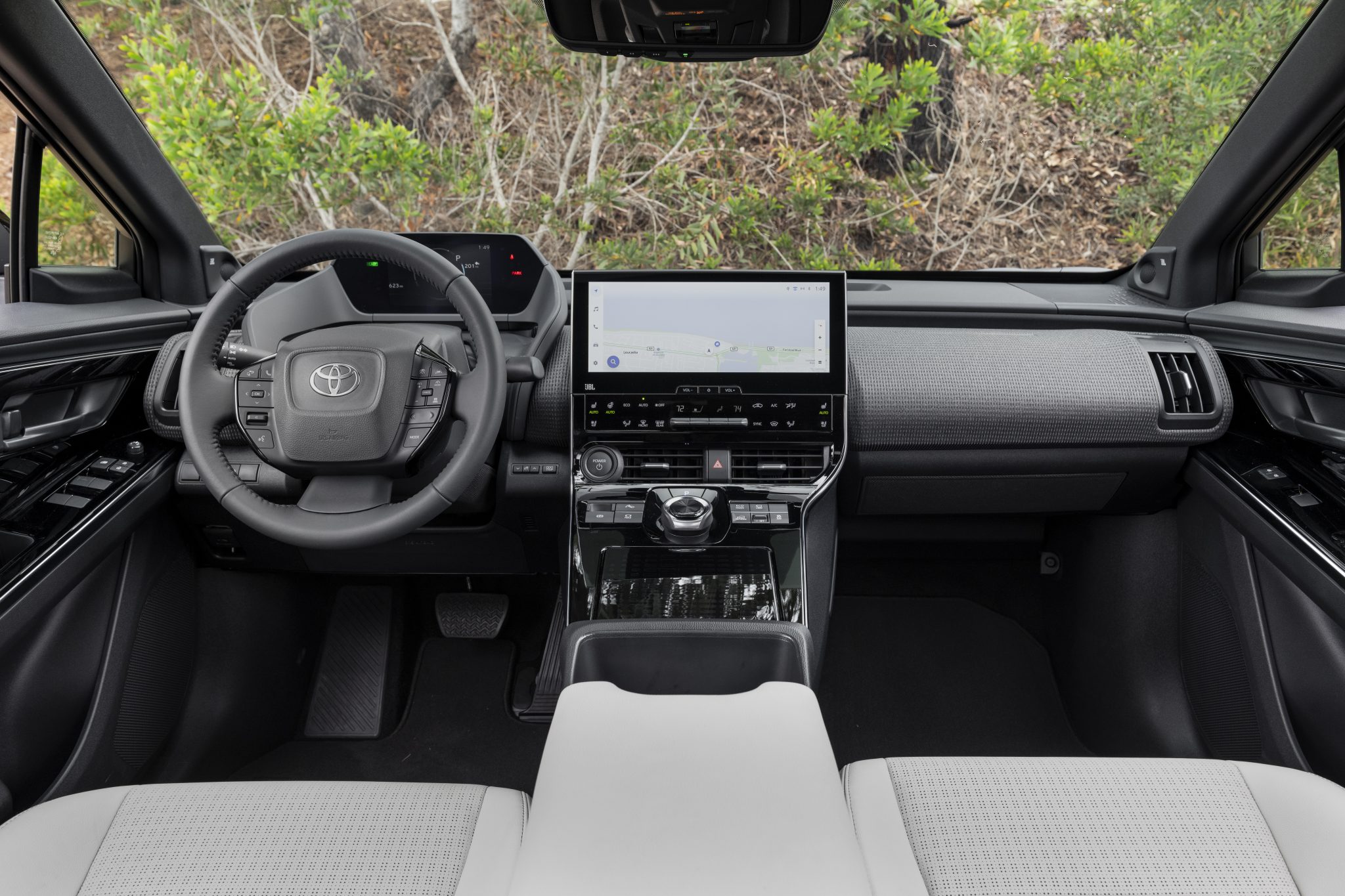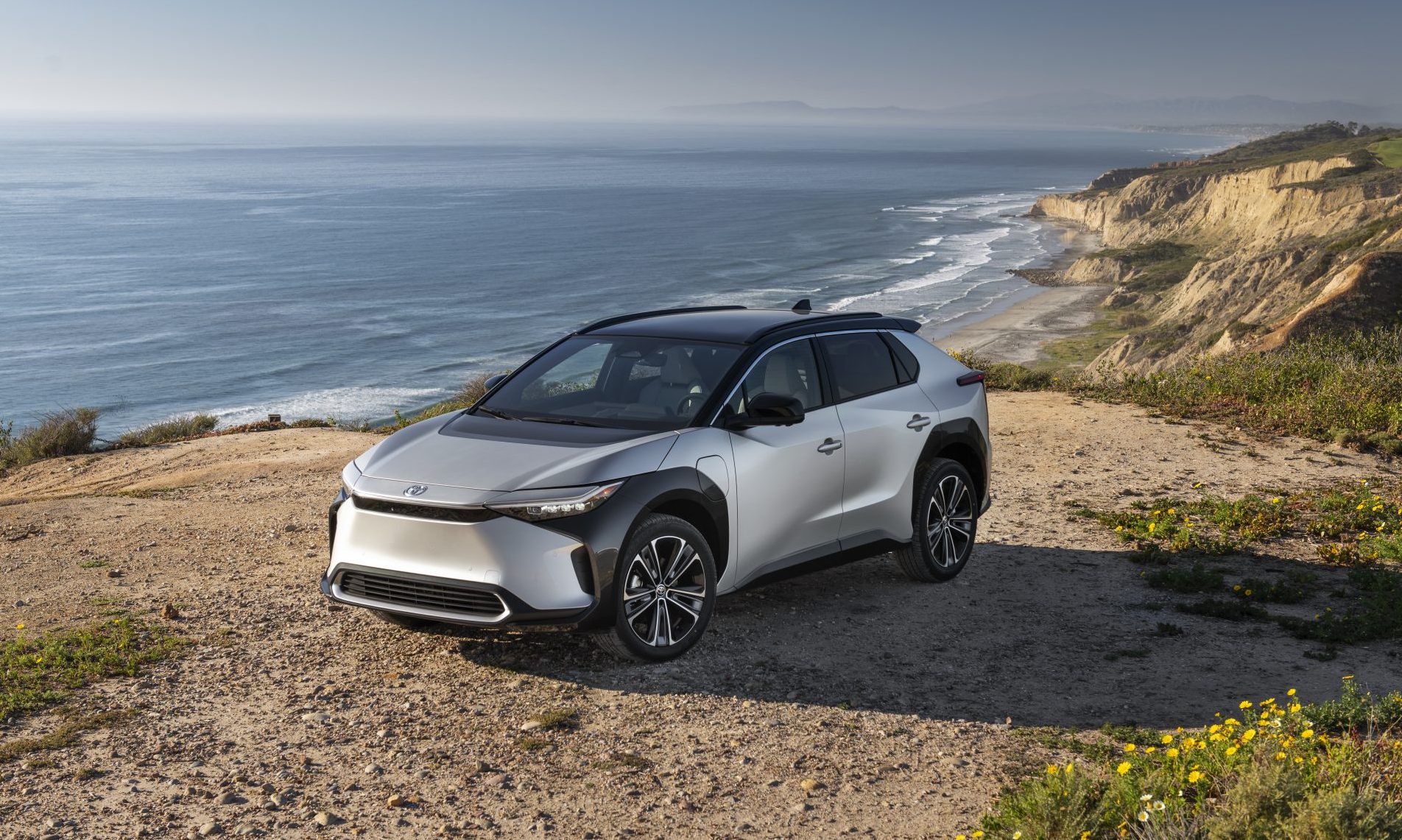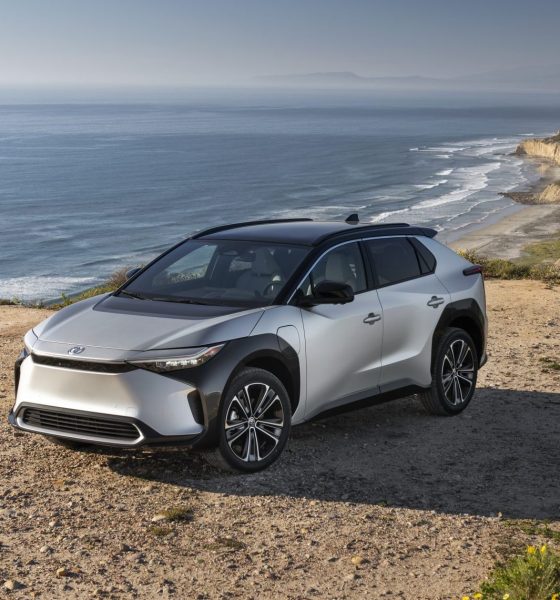Toyota’s bZ4X electric vehicle arrives at dealers this Spring, catalyzing the Japanese automaker’s launch into pure EVs, its first in nearly ten years.
“The all-electric Toyota bZ4X SUV not only looks to further Toyota’s commitment to a carbon-neutral future, but it does so in style,” the company said after launching the vehicle this morning. “Ready to make a fresh mark on the Battery Electric Vehicle (BEV) segment, bZ4X blends bold, modern styling with tech-laden features in an extremely capable platform.”
Credit: Toyota
The bZ4X is Toyota’s first addition to the global bZ series, which stands for “Beyond Zero.” Designed and developed with human-centricity at the heart, Toyota said it hopes to provide more than a mobility solution for customers, but also an innovative space for drivers to imagine a new era of the company’s vehicles.
The bZ4X is a competitive and attractive option for electric vehicle buyers. Important metrics like range and performance are at the focal point of any consumer’s decision in the emerging EV sector, and Toyota brought some competitive numbers to the table with its introductory bZ offering. The bZ4X offers 252 miles of range in its XLE front-wheel-drive models and will start at just $42,000. Not to mention, the bZ4X’s body style is a common selection in the U.S. market. Combining functionality with a sleek design, it is neither bulky nor restrictive.
Credit: Toyota
Toyota said the design of the bZ4X is one that focuses on a “dynamically flowing silhouette.” “The profile of the bZ4X is balanced and sleek, with dynamic character lines that flow from front to rear,” the automaker said. It is a sporty look that also encapsulates some futuristic features, like the enclosed grille area that is simply not feasible on a gas-powered vehicle. Despite its design, it still has the classic Toyota look, keeping the vehicle unique in its own way, not veering too far away from the overall feel of its cars.
Four Trim Levels, All Under $50k
Toyota will offer four trim levels for the bZ4X: two grades with XLE and Limited and two drivetrains, front-wheel and all-wheel-drive.
- 2023 Toyota bZ4X XLE FWD – $42,000
- 2023 Toyota bZ4X Limited FWD – $46,700
- 2023 Toyota bZ4X XLE AWD – $44,080
- 2023 Toyota bZ4X Limited AWD – $48,780
Front-Wheel-Drive trim levels will produce 201 horsepower, with All-Wheel-Drive configurations offering slightly more at 214. Instant torque will help the bZ4X achieve a 7.1-second 0-60 MPH time for the FWD trims and just 6.5 seconds for the AWD drivetrains.
All bZ4X models are equipped with a J1772/CCS1 socket, so home and public charging will be a breeze. Toyota said that there is also a 6.6 kW onboard charger, which allows the bZ4X to charge from low to full in about 9 hours with a Level 2 charger at home or in public.

Credit: Toyota
Toyota’s Big Plans for EVs
About a quarter of Toyota’s total sales in the United States in 2021 were of its electrified vehicles, it said. However, these are not pure EVs, and included hydrogen fuel cell electrics, hybrids, and plug-in hybrids.
There are big plans for pure EVs at Toyota, however, despite its focus on other powertrains for many years. Globally, Toyota plans to expand to around 70 electrified models by 2025, featuring 15 dedicated pure EVs. Seven of the fifteen will feature the bZ brand moniker. “This diverse portfolio of electrified products will help propel Toyota toward its goal of carbon neutrality by 2050,” the company added. “Globally, Toyota has put more than 20 million electrified models on the road – with a CO2 emissions reduction effect equivalent to the CO2 emissions reduction of over 5.5 million BEVs. Over the next nine years, Toyota will invest $70+ billion in electrified vehicles as a whole with the target to launch 3.5 million BEVs globally in 2030.”
Toyota debuts bZ4X SUV concept, kicking off its 15 electric vehicle lineup
I’d love to hear from you! If you have any comments, concerns, or questions, please email me at joey@teslarati.com. You can also reach me on Twitter @KlenderJoey, or if you have news tips, you can email us at tips@teslarati.com.

Elon Musk
Starlink passes 9 million active customers just weeks after hitting 8 million
The milestone highlights the accelerating growth of Starlink, which has now been adding over 20,000 new users per day.

SpaceX’s Starlink satellite internet service has continued its rapid global expansion, surpassing 9 million active customers just weeks after crossing the 8 million mark.
The milestone highlights the accelerating growth of Starlink, which has now been adding over 20,000 new users per day.
9 million customers
In a post on X, SpaceX stated that Starlink now serves over 9 million active users across 155 countries, territories, and markets. The company reached 8 million customers in early November, meaning it added roughly 1 million subscribers in under seven weeks, or about 21,275 new users on average per day.
“Starlink is connecting more than 9M active customers with high-speed internet across 155 countries, territories, and many other markets,” Starlink wrote in a post on its official X account. SpaceX President Gwynne Shotwell also celebrated the milestone on X. “A huge thank you to all of our customers and congrats to the Starlink team for such an incredible product,” she wrote.
That growth rate reflects both rising demand for broadband in underserved regions and Starlink’s expanding satellite constellation, which now includes more than 9,000 low-Earth-orbit satellites designed to deliver high-speed, low-latency internet worldwide.
Starlink’s momentum
Starlink’s momentum has been building up. SpaceX reported 4.6 million Starlink customers in December 2024, followed by 7 million by August 2025, and 8 million customers in November. Independent data also suggests Starlink usage is rising sharply, with Cloudflare reporting that global web traffic from Starlink users more than doubled in 2025, as noted in an Insider report.
Starlink’s momentum is increasingly tied to SpaceX’s broader financial outlook. Elon Musk has said the satellite network is “by far” the company’s largest revenue driver, and reports suggest SpaceX may be positioning itself for an initial public offering as soon as next year, with valuations estimated as high as $1.5 trillion. Musk has also suggested in the past that Starlink could have its own IPO in the future.
News
NVIDIA Director of Robotics: Tesla FSD v14 is the first AI to pass the “Physical Turing Test”
After testing FSD v14, Fan stated that his experience with FSD felt magical at first, but it soon started to feel like a routine.

NVIDIA Director of Robotics Jim Fan has praised Tesla’s Full Self-Driving (Supervised) v14 as the first AI to pass what he described as a “Physical Turing Test.”
After testing FSD v14, Fan stated that his experience with FSD felt magical at first, but it soon started to feel like a routine. And just like smartphones today, removing it now would “actively hurt.”
Jim Fan’s hands-on FSD v14 impressions
Fan, a leading researcher in embodied AI who is currently solving Physical AI at NVIDIA and spearheading the company’s Project GR00T initiative, noted that he actually was late to the Tesla game. He was, however, one of the first to try out FSD v14.
“I was very late to own a Tesla but among the earliest to try out FSD v14. It’s perhaps the first time I experience an AI that passes the Physical Turing Test: after a long day at work, you press a button, lay back, and couldn’t tell if a neural net or a human drove you home,” Fan wrote in a post on X.
Fan added: “Despite knowing exactly how robot learning works, I still find it magical watching the steering wheel turn by itself. First it feels surreal, next it becomes routine. Then, like the smartphone, taking it away actively hurts. This is how humanity gets rewired and glued to god-like technologies.”
The Physical Turing Test
The original Turing Test was conceived by Alan Turing in 1950, and it was aimed at determining if a machine could exhibit behavior that is equivalent to or indistinguishable from a human. By focusing on text-based conversations, the original Turing Test set a high bar for natural language processing and machine learning.
This test has been passed by today’s large language models. However, the capability to converse in a humanlike manner is a completely different challenge from performing real-world problem-solving or physical interactions. Thus, Fan introduced the Physical Turing Test, which challenges AI systems to demonstrate intelligence through physical actions.
Based on Fan’s comments, Tesla has demonstrated these intelligent physical actions with FSD v14. Elon Musk agreed with the NVIDIA executive, stating in a post on X that with FSD v14, “you can sense the sentience maturing.” Musk also praised Tesla AI, calling it the best “real-world AI” today.
News
Tesla AI team burns the Christmas midnight oil by releasing FSD v14.2.2.1
The update was released just a day after FSD v14.2.2 started rolling out to customers.

Tesla is burning the midnight oil this Christmas, with the Tesla AI team quietly rolling out Full Self-Driving (Supervised) v14.2.2.1 just a day after FSD v14.2.2 started rolling out to customers.
Tesla owner shares insights on FSD v14.2.2.1
Longtime Tesla owner and FSD tester @BLKMDL3 shared some insights following several drives with FSD v14.2.2.1 in rainy Los Angeles conditions with standing water and faded lane lines. He reported zero steering hesitation or stutter, confident lane changes, and maneuvers executed with precision that evoked the performance of Tesla’s driverless Robotaxis in Austin.
Parking performance impressed, with most spots nailed perfectly, including tight, sharp turns, in single attempts without shaky steering. One minor offset happened only due to another vehicle that was parked over the line, which FSD accommodated by a few extra inches. In rain that typically erases road markings, FSD visualized lanes and turn lines better than humans, positioning itself flawlessly when entering new streets as well.
“Took it up a dark, wet, and twisty canyon road up and down the hill tonight and it went very well as to be expected. Stayed centered in the lane, kept speed well and gives a confidence inspiring steering feel where it handles these curvy roads better than the majority of human drivers,” the Tesla owner wrote in a post on X.
Tesla’s FSD v14.2.2 update
Just a day before FSD v14.2.2.1’s release, Tesla rolled out FSD v14.2.2, which was focused on smoother real-world performance, better obstacle awareness, and precise end-of-trip routing. According to the update’s release notes, FSD v14.2.2 upgrades the vision encoder neural network with higher resolution features, enhancing detection of emergency vehicles, road obstacles, and human gestures.
New Arrival Options also allowed users to select preferred drop-off styles, such as Parking Lot, Street, Driveway, Parking Garage, or Curbside, with the navigation pin automatically adjusting to the ideal spot. Other refinements include pulling over for emergency vehicles, real-time vision-based detours for blocked roads, improved gate and debris handling, and Speed Profiles for customized driving styles.










